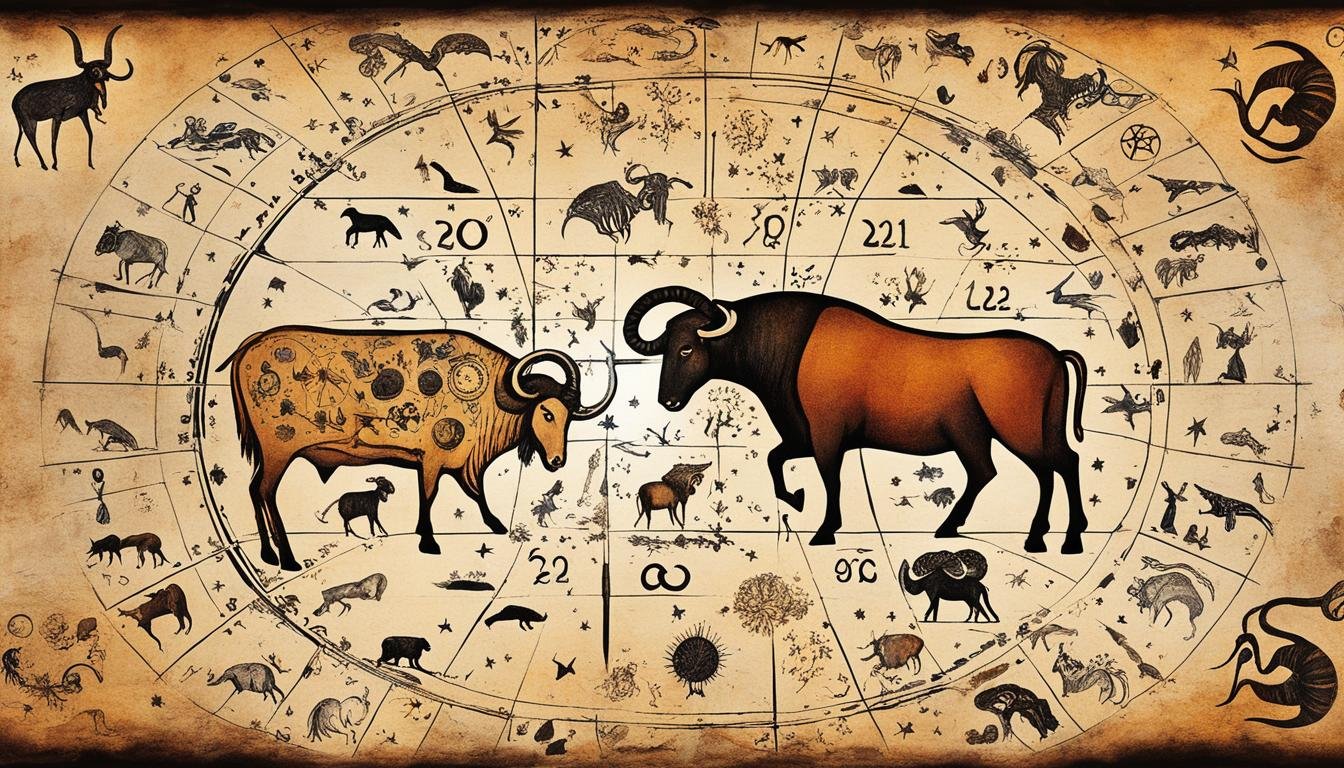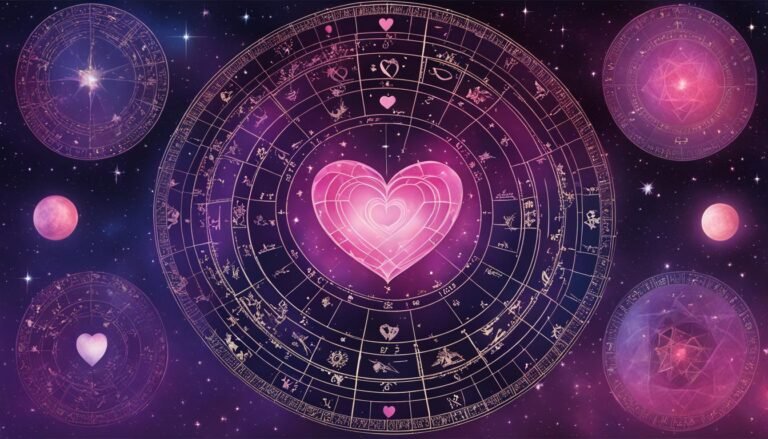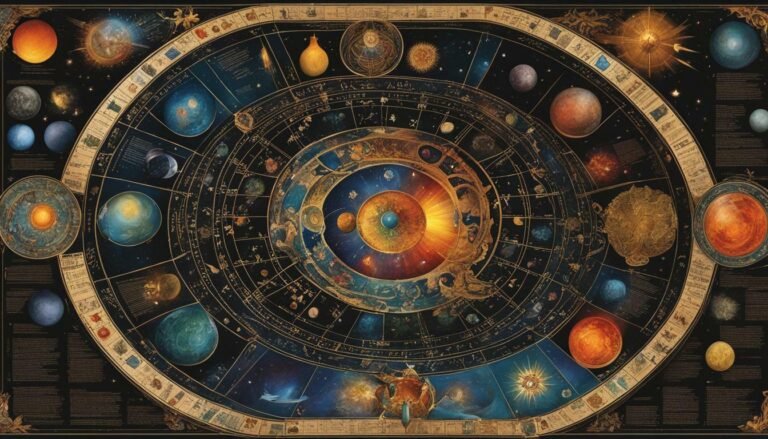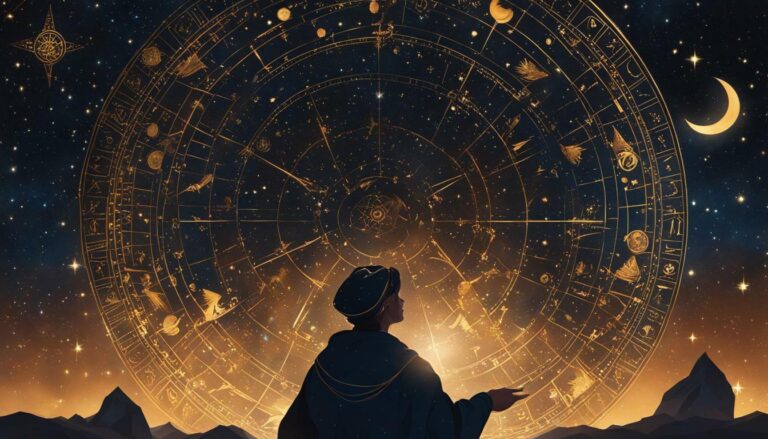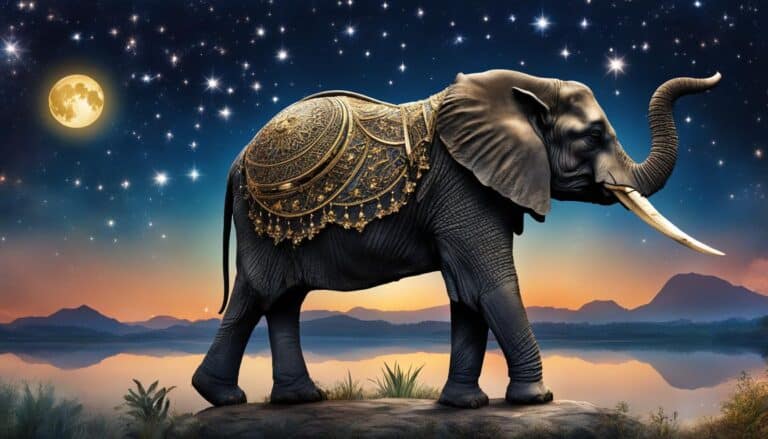Where Did Astrology Signs Come From?
Have you ever wondered about your zodiac sign’s backstory? The storied tapestry of the night sky didn’t just appear out of thin air. It’s the culmination of eons of stargazing and storytelling—the brilliance of the ancients who first connected the dots between our lives and the heavens. The ancient origins of astrological signs stretch back to civilizations whose very ways of life depended on the stars. The evolution of zodiac signs over time mirrors humanity’s endless quest for deciphering the enigma that wraps our planet each night. As we dive into the history behind astrology signs, we uncover a fascinating narrative that tangles with the roots of human culture, reaching deep into the heart of how and why these cosmic symbols became, and remain, central to so many.
Exploring the astrology signs and their origins isn’t just about satisfying a curiosity— it’s about tracing back the threads of how humans have historically sought to understand the complex world around them, looking up for answers written in the stars.
Key Takeaways
- Unravel the rich tapestry that reveals the ancient origins of astrological signs.
- Discover how star patterns influenced civilizations, marking the evolution of zodiac signs.
- Connect with millennia-old traditions exploring the history behind astrology signs.
- Recognize the importance of the stars in guiding ancient lifestyles, integral to understanding astrology signs and their origins.
- Appreciate astrology’s significance that extends beyond mere predictions, embodying humanity’s continuous link to the universe.
A Glimpse into the Sky: Understanding Astrology’s Ancient Roots
As you explore the origins of astrology signs, you’re actually stepping into a grand historical tapestry that stretches across epochs and civilizations. The history of zodiac signs is as old as the night sky itself, but to truly grasp how we got these celestial symbols, you must delve into how our ancestors viewed the firmament above.
The Celestial Calendar: How Farmers and Travelers Relied on the Stars
For generations, the stars served as a reliable calendar for those on the ground. Farmers paid close attention to the heavens, using the positions of stars to determine the best times for planting and harvesting crops. Travelers, too, looked up to navigate vast oceans and deserts, using constellations as their guiding light towards their destinations. The origins of astrology signs are deeply rooted in these practical applications.
From Cave Art to Constellations: Tracing the Ethereal Patterns
What began as simplistic drawings on cave walls evolved into sophisticated maps of the sky. Early humans connected the dots, creating constellations that would eventually align with specific astrology signs and their origins. These patterns in the stars were not just shapes, but held spiritual and divine meanings for the civilizations that gazed upon them.
Astrological Signs in Different Cultures: A Diverse Background
As astrology spread across the globe, cultures from the Far East to the Mediterranean added their own interpretations to the constellations, enriching the history of zodiac signs. By the time Alexander the Great had expanded his empire, the synthesis of various astrological practices set the stage for the zodiac signs we recognize today. This cultural mosaic highlights the diverse roots of astrology, showcasing how human societies have continually sought to understand their place in the universe.
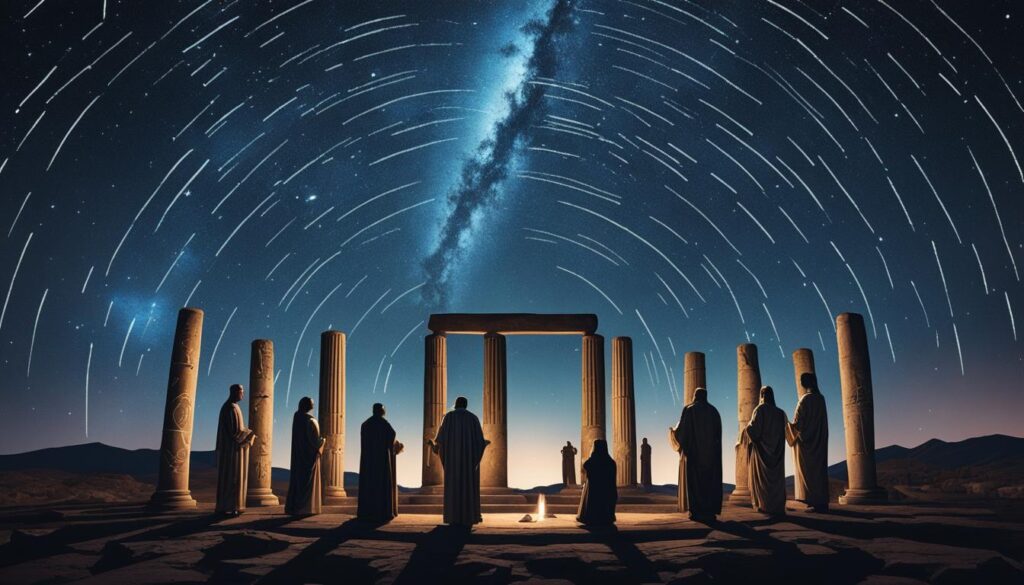
Ancient Babylonia: The Cradle of Astrological Signs
Have you ever wondered about the origins of the zodiac and how ancient astrological signs came to be such a defining aspect of contemporary Western astrology? Look no further than the fertile crescent of Ancient Babylonia, where the framework for Babylonian astrology was meticulously crafted.
The second millennium BC marked a transformative era in which Babylonian scholars and astronomers observed the night sky, discovering patterns that would eventually form the basis of astrology. They didn’t simply gaze upon the stars; they imbued them with divine and ominous meanings, often interpreting these celestial events as messages from the gods.
- The meticulous record-keeping of celestial phenomena such as the Venus tablet of Ammisaduqa is a testament to the Babylonians’ celestial scholarship.
- By dividing the zodiac into twelve equal segments, they laid the foundations for Hellenistic astrology, naming each constellation in ways that are surprisingly familiar to us today.
Their vision of astrology, deeply connected with divine foretelling, resonates through the ages. The Babylonian heritage in celestial divination is not merely a historical footnote; it’s a living tradition that continues to influence modern astrological practice.
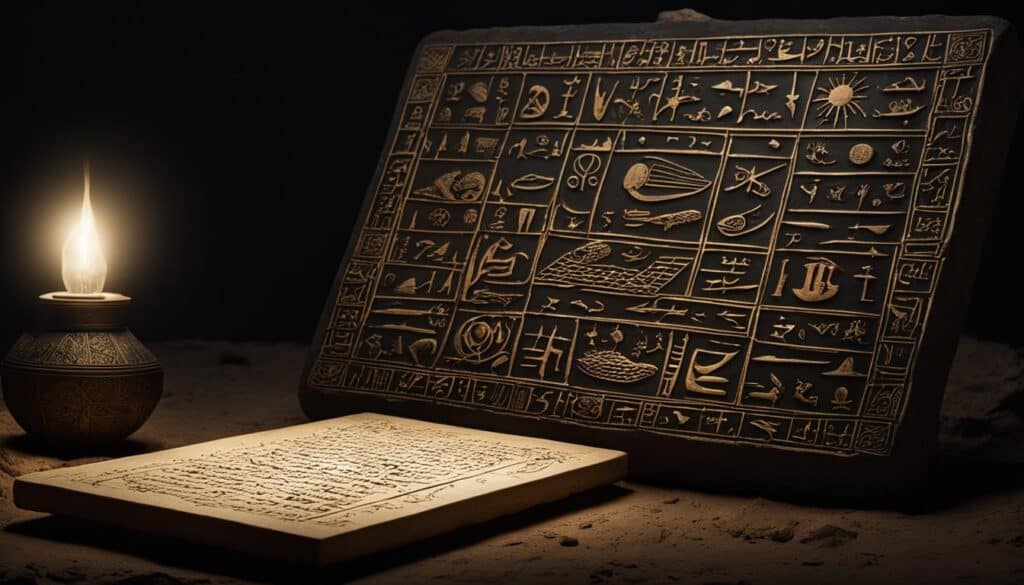
As you delve into your horoscope or mull over the traits associated with your astrological sign, remember the ancient Babylonians. Their astronomical ingenuity is the underpinning of that very system, establishing a cultural cornerstone that endures into the present day astrology.
Greek Astronomy and the Twelve Zodiac Signs
If you’ve ever wondered about the ancient origins of astrological signs, you can look to Greek astronomy for answers. It’s during this epoch that the framework of the zodiac as we know it began to take shape. Not merely content with observing the heavens, Greek scholars, led by the astute insights from Ptolemy, sought to document the cosmos, carving a legacy in the stars that has endured for millennia.
Ptolemy’s Tetrabiblos: Codifying the Zodiac
The history of zodiac signs cannot be narrated without paying homage to Ptolemy’s influence on astrology. His seminal work, the Tetrabiblos, was instrumental in codifying the ancient zodiac, meticulously linking celestial patterns to terrestrial events. His treatise laid the groundwork for Western astrology, embedding the study with an intellectual rigor that has, in many ways, stood the test of time.
Connecting Signs to Seasons: The Logic Behind the Zodiac
The Greeks were masterful in connecting the zodiac signs to seasons, deriving logic from the synthesized movements of celestial bodies. They designated dates for each zodiac sign based on the Sun’s passage through the corresponding constellations. This synchronization of celestial and seasonal cycles was revolutionary, cementing the holistic development of not just astrological, but astronomical thought as well.
The Enlightened Sky: Interplay between Constellations and Sun’s Passage
Our journey through the stars brings us to a profound interplay between the constellations and the Sun’s passage, which Greek astronomers illustrated with celestial precision. However, due to the precession of equinoxes, the alignment of these constellations with our calendar has shifted, a testament to the fascinating, ever-changing tapestry of the cosmos.
Tales of the Zodiac: The Mythology Behind Astrology Signs
Delving into the mythology of astrology signs reveals a tapestry of zodiac sign stories, where significant zodiac animals and figures play a pivotal role in the narratives that have shaped human understanding of the stars. Greek myths, in particular, have bestowed each astrological sign with characteristics and tales as deep and fascinating as the constellations themselves.
Aries to Pisces: Stories woven into the Stars
From the valorous Ram of Aries, a character plucked from the heroic journeys of the Golden Fleece, to the compassionate dual fish of Pisces recalling the transformative love of Aphrodite and Eros, each constellation bears a legend. These narratives, imparting wisdom and caution, have echoed throughout millennia, stirring the imaginations of astrologers and laypersons alike.
The Symbolism and Significance of Animal Representations
In the grand theater of the sky, each significant zodiac animal is not just a celestial marker but an embodiment of traits humans have aspired to and identified with. The steadiness of the Taurus Bull or the regal daring of the Leo Lion, these animals serve as cosmic mascots that mirror our inherent and aspirational qualities.
The Impact of Greek Myths on Zodiacal Interpretations
The influence of Greek mythology on the interpretation of astrology signs cannot be understated. It has endowed each sign with a richness that goes beyond mere dates and alignments, providing a mythical framework that continues to captivate those who seek to untangle the mysteries of their zodiacal identities.
Conclusion
The odyssey of the evolution of zodiac signs illustrates more than a historical curiosity; it reflects a visceral human drive to seek patterns within the vast tapestry of the night sky. It’s quite mesmerizing when you ponder how the legacies of ancient Babylonians and their celestial mappings, along with the Greek elaborations on these astral divisions, continue to swirl in today’s astrological practices. You look up at the stars, much like your ancestors did, and you’re partaking in a tradition that has been timeless, surviving the relentless march of the cosmos and the shift of the stars themselves.
This narrative stems from a pursuit of understanding the history behind astrology signs, that despite the scientific advances and new astronomical discoveries, these signs remain embedded in the cultural consciousness. Astrology for many transcends just a pastime; it’s a means to navigate through life’s uncertainties—a looking glass for introspection or a semblance of order in the apparent chaos overhead.
So, as you reflect upon astrology’s rich tapestry—from the furrows tilled under ancient constellations to the modern horoscope sections—you’re engaging with a powerful human tradition. Whether you delve into astrology for guidance, inspiration, or just a momentary flirtation with the mystery of your sign, remember that the stories written in the stars are as enduring as they are intriguing. They are stories shared beneath the same sky, a pageant of stars that has fascinated humanity from the very beginning.
FAQ
Where did astrology signs originally come from?
The ancient origins of astrological signs date back to the early civilizations, like the Babylonians, who created a zodiac system dividing the sky into twelve equal parts. This system was later refined by the Greeks, who integrated it with their own astronomical observations and mythology, shaping the evolution of zodiac signs.
How did ancient farmers and travelers use the stars?
Farmers relied on the celestial calendar to determine planting and harvesting times, while travelers used the stars for navigation. The position of stars and constellations helped them keep track of time and direction throughout the year.
Can you trace astrology signs through different cultures?
Yes, astrology signs have a diverse background and can be traced through various ancient cultures such as the Egyptians, Chinese, Mayans, and Indians, who all observed the heavens and developed their own systems of astrology, which contributed to the rich tapestry of astrological practice.
What is the significance of Babylon in the history of astrology?
Ancient Babylonia is often referred to as the cradle of astrological signs. Babylonian astrologers meticulously recorded celestial phenomena and associated them with divine messages, laying the groundwork for the zodiac system that significantly shaped the origins of the zodiac as we know it.
How did Greek astronomy contribute to the zodiac signs?
Greek astronomers, like Ptolemy, documented and codified the system of twelve zodiac signs, aligning them with the seasons through the Sun’s passage through the constellations. Their work was influential in the development and widespread use of the astrological signs that are familiar today.
What are some stories behind the zodiac signs?
Each zodiac sign has a background story or mythology related to it. For example, Aries is linked to the story of the Golden Fleece, while Pisces is associated with the tale of Aphrodite and Eros escaping Typhon. These stories influence the representation and interpretation of the signs.
Why are animals used to represent zodiac signs?
Animals are used to represent zodiac signs due to their symbolic qualities and roles in ancient myths. The characteristics attributed to these animals mirror the traits associated with each astrological sign, such as the courage of a lion for Leo or the stubbornness of a bull for Taurus.
How did Greek myths contribute to the interpretation of zodiac signs?
Greek myths provided a rich narrative to each zodiac sign, personifying them with gods, heroes, and creatures that embody the signs’ intrinsic traits. This mythological layer added depth and cultural context that significantly impacted how zodiacal interpretations were formed.

